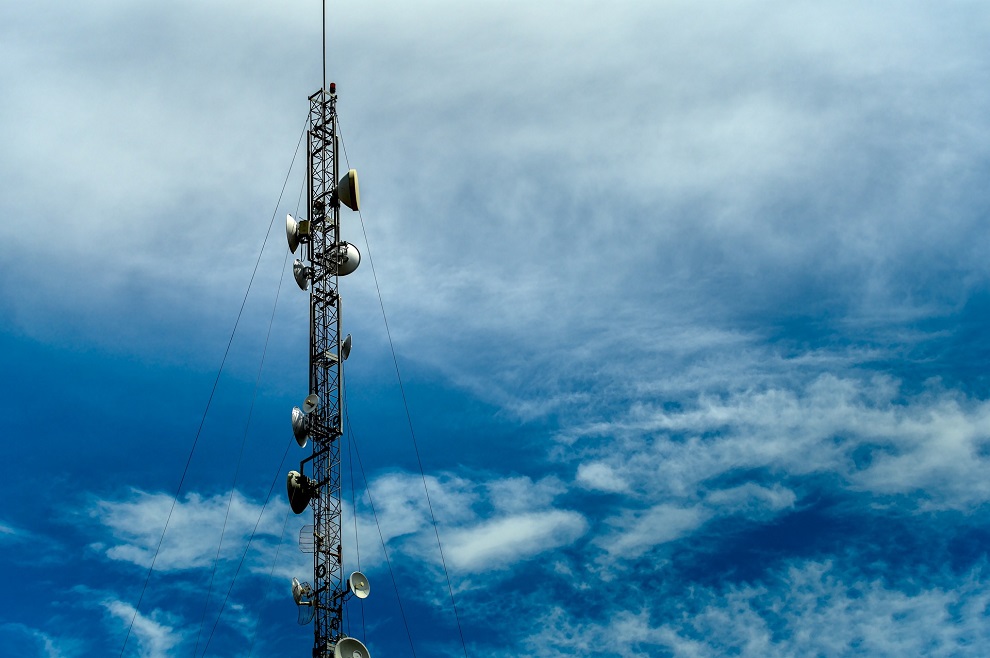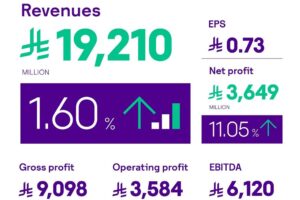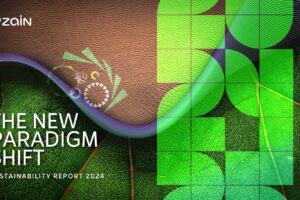PREDICTION #1: VIRTUAL AND PHYSICAL, MIX AND MATCH
AS WE INCREASINGLY SEE MORE VIRTUAL CONTENT APPEARING IN THE PHYSICAL ENVIRONMENT IN 2023, AN AVATAR ECONOMY WILL START TO EMERGE.
It’s very early stages, but, as I explore below, the Metaverse is about to make the web truly immersive. Yet the ability to combine physical and mixed realities will be dependent on network capabilities to accelerate adoption. The current coverage of 5G differs across the world: we see the US leading with ~80% coverage in 2022, whilst the rest of the world is at only ~30%.
In 2023, 5G devices are expected to evolve with more spectrum aggregation capabilities, improved power efficiency and low-latency capabilities. The 5G network buildout is expected to reach 85% by 2028. The use of extended reality (XR) devices is dependent on both the 5G device evolution and the 5G network buildout due to their speed, latency, and capacity requirements.
Virtual experiences
One of the industries that is looking at taking advantage of the better speeds and lower latency of modern telecommunication networks are online retailers that are bringing the ‘bricks-and-mortar’ experience to online shopping. We are seeing more 3D content and augmented reality (AR) ‘try-ons’ to boost buying confidence and influence purchase decisions. At the same time, physical stores are utilizing virtual elements to entertain and deliver a richer in-store experience. Even in entertainment, the recent virtual concert success by the Swedish pop group ABBA showed artists and impresarios alike that there’s big money in avatars.
Brands like Gucci are taking these digital experiences a step further, setting up virtual stores in gaming platforms – enabling customers’ avatars to try and buy the latest collections with a revenue-share model that benefits both brands.
Network capacity will be crucial to be able to deliver on this prediction and IFS cloud with its project management, asset management and field service modules is a perfect fit to support the aggressive infrastructure/network rollout as Telecom operators pursue this trend/prediction.
PREDICTION #2: ENTER THE TELECOM PLATFORM
IN 2023, WITH 5G, THE TELECOM NETWORKS WILL BE MORE OPEN AND PROGRAMMABLE LEADING TO AN INCREASED CONSUMPTION OF TELECOM NETWORK RESOURCES VIA OPEN APIS.
The IT industry has long had the API (Application Programming Interface) economy but in Telecom this has so far not been seen. This is mostly because the generations of Telecom networks before 5G have not been so good at exposing their properties and values. Throughout the evolution of 2G-4G networks, all the operators focused on the same capabilities: voice, SMS text, and mobile internet connectivity to browse the web and stream content. Currently the majority of the 5G deployments worldwide are still non-standalone (NSA), meaning they still rely on some 4G network technology. However, in 2023 as the standalone (SA) 5G development starts to emerge, the use of full 5G switches and wireless antennas will liberate the new dynamic capabilities of 5G. Many industries are contributing to the 5G standalone (SA) 3GPP standardization resulting in a huge B2B potential that has been unlocked. This business potential is estimated by various analysis firms to be worth ~700 billion USD in 2030.
Share and growth rate for global total 5G-enabled B2B opportunity for service providers
New platform capabilities
App developers from other industries could, with more sophisticated telecom network platform exposure, look at various business opportunities. For example, exciting ongoing collaborations that will likely see the light of day in 2023 already include:
• Capabilities to land drones safely: NASA/FAA, and the EU/EASA, each evaluate a regulatory system for controlling drones beyond line-of-sight (BVLOS).
• Vehicle to vehicle communication: Vehicle-to-Everything (V2X) communication is a system that supports a seamless peer-to-peer information transfer between vehicles and infrastructure. Both auto players and network providers in EU and US are shaping the V2X spectrum policy
• Manufacturing (factory automation): OPC Unified Architecture (OPC UA), a machine-to-machine communication protocol used for industrial automation is a key enabler for Industry 4.0. The 3rd Generation Partnership Project (3GPP) that shapes standards for mobile communications have now added 5G wireless, converging industrial networks for Ethernet Time Sensitive Networks (TSN).
• Broadcasting: The European Broadcasting Union (EBU) has established a working group on the role of 5G in Content Production (5GCP), while 3GPP is studying the requirements of Audio and Video Production
The collaborations above will also further push for the merging of information technology (IT) and operational technology (OT). The common dataset between IT and OT is increasing, so in 2023 we will see further attempts to converge the two areas. For Telecoms this means that TM Forum Open APIs will become something that IT systems must start taking seriously if organizations wish to be a preferred partner in service management, supply, and logistics. The IT companies that do this well will also be the ones that could deliver on the IT/OT convergence benefits and reap the benefits of the Telecom networks’ openness by expanding their customer footprint.
According to Gartner, enterprise 5G projects primed by an IT system integrator or IT/OT service provider will rise from 5% in 2021 to 50% by 2025.
IFS cloud is perfectly positioned to help Telecom operators to manage these new partner relationships as well as managing the realization of these new business opportunities with the project, service, and asset management capabilities. As IFS is already present in many of the other industries that Telecom operators would want to setup business relationships with the IFS industry knowledge could be key for them to succeed as IFS could be the guiding star for them when they venture into adjacent industries.
PREDICTION #3: NO GREEN WITHOUT DIGITAL – A SUSTAINABILITY FOCUS
ALL TELECOMS PLAYERS IN 2023 WILL NEED TO CLOSELY SCRUTINIZE AND ESCALATE SUSTAINABILITY INITIATIVES
Our voracious use of mobile-connected music, video and social media platforms has sobering energy consequences. In July 2017, Despacito, with the help of Justin Bieber’s version, became the most widely streamed song of all time. Researchers from the European Commission found that the 4.6 billion global streams had used as much electricity as the combined annual electricity consumption of Chad, Guinea-Bissau, Somalia, Sierra Leone, and the Central African Republic.
Minimizing power consumption
For each new generation of mobile technology, from 2G through to 5G, the energy needed to transfer each bit of data through the network has lessened. For example, replacing 2G/3G with 4G is significantly increasing the capacity for the same spectrum. It also enables the use of more efficient energy-saving functionalities, offered by the 4G standard. 5G technologies are designed for high capacity and low network energy consumption, including significantly improved support for energy savings during low-to-medium traffic periods. Looking ahead, achieving game-changing energy-saving capabilities within 6G will be pivotal. This includes exploiting new low energy device chipsets, and where possible base stations powered by renewables.
Improvements can be realized by modernizing existing sites that have 2G, 3G and 4G radios installed with a new-generation, multi-standard, multi-sector, and multi-band radio that supports 2G-to-5G mobile standards. Under the same network coverage and performance requirements, the modernized site shows lower operational cost and reduced equipment footprint, while being ready for 5G. Measurements taken from an operator in the Middle East show up to 52% energy consumption reduction compared to previously deployed radios. The reduction in energy consumption is equivalent to 7.6 tons of CO2 emissions per site, per year for high-tier sites configured with 4 Long-Term Evolution (LTE) carriers.
For service providers, energy is typically the third-largest network-related operating expense. Energy-reducing software solutions making use of load variations allow the power consumption of modern radio equipment to vary up to 97% between full-traffic and no-traffic hours. This makes being on the latest software more important than ever.
Climate change awareness is increasing among Communications Service Providers (CSPs), who are beginning to realize the cost of inaction. As there is ‘no green without digital’, CSPs are also enabling other business sectors to decarbonize.
Sustainability is an ethical duty, but also a business imperative, providing advantages in the form of energy savings, new markets, financing, and greater customer intimacy. Environmental, social and governance (ESG) criteria are also critical to long-term sustainable business performance.
To reach the sustainability targets, Telecom operators would need to be aggressive with their network planning and to be able to realize the network modernization needed IFS cloud with its project, service and asset management capabilities could be the difference between success and failure.
In forthcoming blogs throughout the year, I’ll be commenting on further telecoms sector trends and breakthroughs as they unfold.












